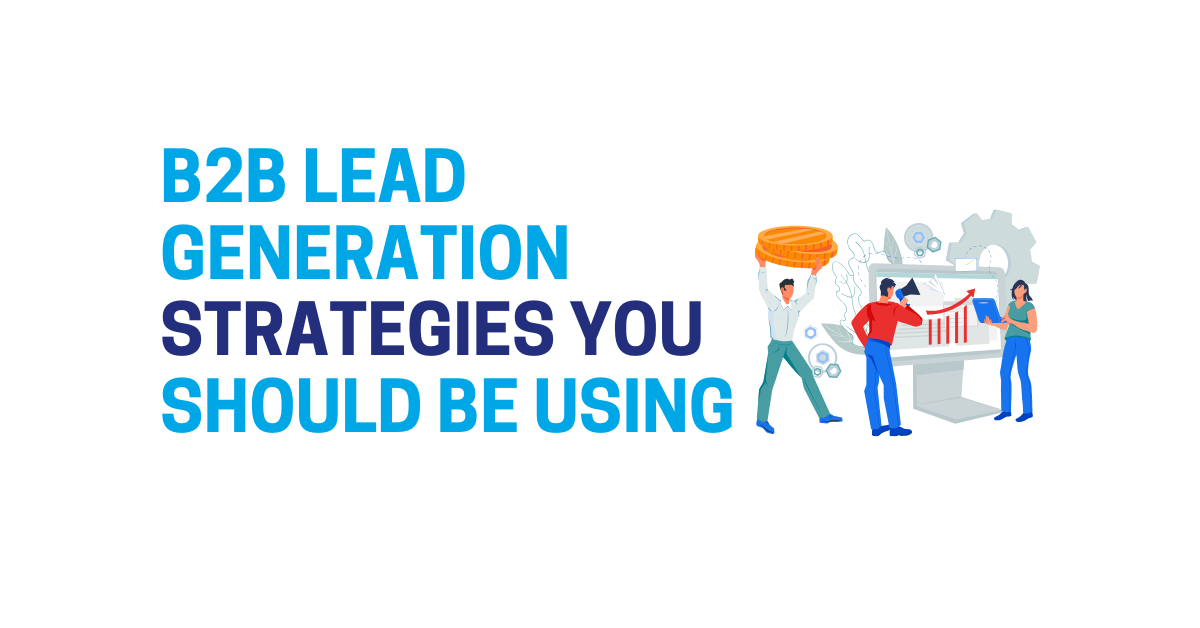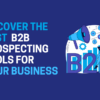B2B Lead Generation Strategies: A Comprehensive Guide
Generating leads from business clients is arguably more complex than in the consumer segment. You have to target specific decision-makers and hope they can get buy-in from their teams before purchasing from you.
Because of this, the top B2B firms invest significantly in lead generation strategies. They use tactics proven to work in different industries to get the stakeholders who matter to give their assent to any deal. Naturally, it is a complex process, but also an achievable one. Discover why businesses trust us for B2B lead generation and how we can support your success.
This guide explains B2B lead generation and discusses the most effective strategies for closing deals, earning more leads, and “best practices” for client acquisition.
Understanding B2B Lead Generation
But first, what is B2B lead generation?
B2B lead generation is a way of acquiring business customers.
A lead in this context is any business likely to want to buy from you.
Naturally, B2B lead generation only applies to business-to-business firms. It doesn’t apply to business-to-consumer (B2C) companies, like hotels, restaurants, and phone shops.
Because of this, the underlying process can be quite different.
B2C lead generation often involves flashy advertising. However, B2B lead generation has to be significantly more strategic. Most employees in other firms can’t make purchases on a whim; they have to go through others.
As such, B2B lead generation requires nuance and careful target selection. It also necessitates crafting relationships over longer time frames, sometimes upwards of 18 months. The nurturing process has to continue long-term before winning large contracts.
Effective B2B Lead Generation Strategies
Of course, knowing what B2B lead generation is is only half the battle. You must also understand how to do it effectively.
Fortunately, this section is here to help. It runs through some of the most effective B2B strategies, showing you what’s likely to work (and how techniques differ from conventional B2C methods).
Start With Your Content
While it might sound strange, we recommend starting with content. The more you can put yourself forward as an expert and authority in the B2B space, the more likely you will succeed.
The business-to-business sector thrives on coming across as an enterprise that understands its niche. Therefore, if you can prove you can do something just 10% better than a rival firm, you can win clients.
Make sure your content is “high-value.” Look for ways to make it as original as possible.
If possible, add new data to the conversation. Create documents that other people in the industry can link to (for SEO). Get your name out there by producing ground-breaking research.
If you can repurpose old content, do that, too. Updating it for the current year or changing it slightly to reflect new knowledge can encourage Google to promote it.
Begin Cold Calling And Emailing
Another tactic is cold calling and emailing.
No–nobody likes this approach. But it works in B2B.
Why are cold calling and emailing so successful in business-to-business relationships?
It comes down to context. Most businesses welcome people who contact them with proposals to make their firms better and more profitable. If you demonstrate that your products/services work, they are more likely to want to go further (and hence become a “lead”). For a more detailed approach, explore our guide on cold calling best practices to improve your outreach success.
Focus on how you can solve prospects’ challenges. Look for unique ways you can solve problems you know they have.
For example, if you have made an app to help them organise their field staff, talk about how it can help them.
Use Live Chat On Your Website
You could also use live website chat to generate more leads. Today’s technology is vastly more advanced, capable and conversational than even three years ago, so it’s worth a shot.
AI-powered systems can engage visitors the moment they arrive at your site. Then, they can talk to them about your solutions, almost like an automated sales presentation, while answering their questions.
Prospective clients can also ask these systems more about what your service does and how it can help them. It can even provide tailored answers to their questions, based on their requirements.
Add Social Media Marketing To Your Stack
Social media marketing is another method for generating B2B leads. Reaching out on professional platforms, like LinkedIn, can be highly effective.
For example, you could:
- Directly contact decision-makers in target client firms
- Leverage LinkedIn ad targeting to reach people who could benefit from what you sell
- Share valuable content that will be interesting or helpful to the industry/community
Social media marketing works because it lets you reach individual people. You can’t usually do that with B2C-style marketing, so it isn’t as helpful for B2B firms. But when you take a tailored approach to social media outreach, you can begin to generate results quickly. Stay ahead of the competition by checking out Forbes’ latest insights on B2B social media marketing trends
Try Account-Based Marketing
You could also try “account-based marketing”–or upselling to existing customers. Finding ways to encourage them to fork over even more money for your services can be highly effective.
High-value accounts are often the most promising. These are usually the companies benefiting from your services the most. Extending revenues from these by just a few per cent can tremendously impact overall business performance. For a deeper dive into ABM, check out LinkedIn’s insights on account-based marketing best practices.
Email Marketing
Email marketing has a similar feel. It allows you to reach out to leads individually, helping you speak to them personally.
You can send out blanket emails. However, tailoring them to the client’s needs usually works better.
So-called “lead nurturing” campaigns are where you drip-feed prospects’ emails over a long period, hoping they will convert. The more they know you, the more likely they will buy from you.
Most companies use automation software for this. For example, MailChimp might send clients a nurturing email every three days or so.
You can also write emails from scratch. These are usually more effective, but it depends on your business. Sometimes, your services work only for specific firms while other times, they are compatible for more clients in an industry. Learn more about creating high-converting email campaigns in HubSpot’s guide on effective B2B email marketing.
Referral Programmes
Referral programmes are another way for B2B enterprises to generate leads. These incentivise existing clients to act as customer recruiters.
Referral programmes are effective because they work through multiple channels.
- Clients align with your firm’s needs because doing so generates financial rewards for them
- Prospective clients receive word-of-mouth marketing from existing clients (which is often the most powerful type)
- Referrals act as “social proof” in the business sector, with ambassador companies able to describe how you helped them
Furthermore, referral programmes have another benefit: they’re easy to arrange. Once you incentivise clients, they will do the rest. There’s no complicated outreach.
Gated Content
Finally, you could use gated content as a lead magnet or generation technique. This approach encourages email sign-ups from businesses likely to benefit from your products or services.
Gated content could be ebooks, newsletters, or guides. However, you could also gate webinars and virtual training events, promising prospects even more value.
How To Generate More B2B Leads
Generating more B2B leads can be challenging, but also possible. Once you implement the techniques described here, your success can be tremendous.
Sales lead generators are everywhere. It’s just a question of finding them.
Most B2B firms start by describing their ideal business customer profile. Here, you try to understand who you are selling to.
Then, you optimise your websites for lead capture by including strong calls to action (CTAs). These could include:
- Download our free ebook
- Get a free consultation
- Start your free trial
- Download or demo the solution today
- Sign up for massive discounts
After that, look for irresistible lead magnets that appeal to your prospects. Try to find a pain point and solve it upfront.
For example, you might write a report analysing a problem they face in return for their email addresses. Or you could provide a template that makes a business task easy (something a UK lead generation company might recommend).
Following that, look for channels that your B2B leads are on. Don’t stick to LinkedIn exclusively. Adopt an omnichannel approach to get your message out.
Search for where leads are most active. If you don’t know where that is, get a lead generation service to do it for you.
When using LinkedIn, maximise the platform’s potential. Share industry problems and solutions, and join groups in your niche. Use the platform’s ad manager and Sales Navigator tools to find decision-making stakeholders. Leverage resources to find individuals who can help you.
Where possible, host events and webinars to get people in your industry interested in what you do. Don’t be shy!
Look for strategic partnerships when it works for you. Collaborate with complementary businesses and share audiences to generate leads together.
Don’t be a business that tries to go it alone. B2B brands thrive on accessing expert knowledge from the outside.
Finally, use a lead generation company in the UK to guide your efforts. Specialists can put systems in place that let you generate significant lead volumes (without doing the hard work yourself). See how businesses have benefited from expert B2B lead generation in our client success stories.
Best Practices For Lead Generation
Adopting the above strategies can help you generate more B2B leads but you still need to do it right. Don’t fall into the trap of blindly following strategies.
Here’s our advice as a lead generation company:
- Focus on producing quality content over quantity since this will benefit your business audience the most. You want to avoid getting a reputation for “thin” content.
- Use multiple channels (not just LinkedIn) to reach people who matter. Don’t be afraid to target non-decision-makers in prospective firms since they can still influence decision-making processes.
- Build trust and authority in your work. Use case studies and client reviews to highlight your abilities and showcase your success.
- Follow up promptly with clients and leads. Don’t leave prospects hanging if they show interest in what you do. Ensure you have literature you can give them immediately, and a person on your team they can contact.
- Use customer relationship management (CRM) software and other lead management tools. Establish a system that sales operatives can use.
- Continue nurturing leads over many weeks and months. Accept that it takes a long time to convert a prospect in the B2B space.
- Make the value you offer clear. Show how asking high prices can translate into real benefits for the companies you serve.
- Personalise your outreach, addressing decision-makers in target firms by name. Make it clear you have a solution crafted for them.
- Put more effort into content marketing. Write emails, newsletters, video scripts, and webinar series to build authority and showcase expertise.
Don’t worry if you can’t follow all these strategies immediately. Try implementing one or two every month until you check them off the list.
Which B2B Lead Generation Methods Work Best?
Finally, focus on the best B2B lead generation methods. Look for strategies that transform your business prospects and enable you to emerge as the industry leader.
Most B2B companies find that the following methods are best:
- Collaborations and partnerships
- Networking and going to industry events
- Producing high-quality, unique content
- Cold calling and outreach
- Virtual events and webinars
However, you shouldn’t rely on this list exclusively. Experimentation is critical. For example, email marketing might be the most effective approach if you already have a mailing list. You could run campaigns with educational content or personalise communications to businesses based on their behaviour.
Likewise, if you already have a significant presence, social media marketing could work. LinkedIn, Facebook, and X are all reasonable platforms for B2B companies. These let you engage directly with decision-makers in target firms, sharing thought leadership, action lists, or ad campaigns.
Ideally, you should continue experimenting to find solutions that work for you. Don’t just copy what others are doing.
Now You Understand B2B Lead Generation
Having read this article, you should better understand B2B lead generation. As you will have seen by now, it is not the same as B2C marketing.
B2B’s primary challenge is nurturing client relationships over a long period. It can take months to transform a prospect into a paying customer.
That said, the payoffs are bigger in the B2B space. A single contract could be worth millions.
If you need help with B2B lead generation, use a lead generation specialist. These firms help you connect with businesses that could benefit from your services.

Ryan Whyte is a Director of The Lead Generation Company where he leads a team of B2B telemarketers to deliver high-quality leads for clients. With a strong background in campaign management and a focus on driving results, Ryan is dedicated to optimising strategies that maximise client success in B2B lead generation.


















